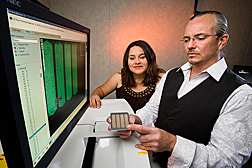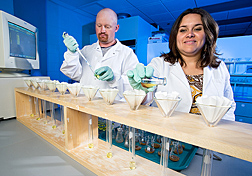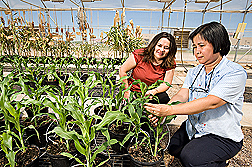For Want of Microbes, Soil Processes
and Function Could Be Lost
The health of entire ecosystems can depend on tiny soil microbes, which are responsible for most decomposition processes. Veronica Acosta-Martinez has been studying these microbes on croplands, grasslands, and forests, and she’s discovered that changes in soil microbial communities can give a relatively early indication as to how a particular crop or practice is affecting the soil.
She has seen microbial communities respond within a few years to changes in land use or cropping systems, while it can take 10 years or more for changes to occur in other soil properties.
Acosta-Martinez is a soil microbiologist at the Agricultural Research Service’s Wind Erosion and Water Conservation Unit in Lubbock, Texas. Since 2006, she and Ted Zobeck, a soil scientist also at Lubbock, have been taking soil samples from 26 farms participating in the Texas Alliance for Water Conservation (TAWC). Vivien Allen from Texas Tech University at Lubbock began the Alliance as part of a broad study in the Ogallala Aquifer region on the effect of farming practices on soil and water conservation.
TAWC includes a team of scientists who study all the properties of soil and their relationship to farming practices and soil productivity and quality. It is a partnership among farmers, ranchers, industry, the High Plains Underground Water Conservation District No. 1, ARS and other government agencies, Texas Tech University, and Texas A&M University System’s Texas AgriLife Research.
“My role on the team is to look at soil microbes for early signs of changes in the soil microbial component,” Acosta-Martinez says. “We have to look at all properties—soil microbes can’t tell everything. But they are key to changes in soil processes that can affect soil quality.”
She has been the only ARS microbiologist doing these measurements in the Texas High Plains, a region of many soils that have less than 1 percent soil organic matter. “This is a semi-arid region with crops and livestock that depend on water from the declining Ogallala Aquifer. This is why alternative management is being evaluated in the region. Research dealing with soil and water conservation is imporant for our future generations.”
Microbes Save Water
With the help of Scot Dowd, then working as a microbiologist with the ARS Livestock Issues Research Unit at Lubbock, Acosta-Martinez adapted new DNA technology, called “pyrosequencing,” for analysis of microbial species diversity in soil.
These microbes—bacteria, fungi, and protozoa—release enzymes that drive the important carbon, nitrogen, phosphorus, and sulfur cycles in soil and facilitate turnover of organic matter, making nutrients available to plants.
In fact, microbes make soil what it is—affecting its structure and its ability to hold water for plants.
TAWC includes 3,954 acres of land farmed various ways—with and without crop rotations, with integration of livestock and crop production, and with various forms of irrigation. It also includes nearby grasslands that are highly erodible and that have been rested from farming for a decade under USDA’s Conservation Reserve Program (CRP).
“These CRP lands had never been evaluated by looking at soil microbes and enzyme activities involved in nutrient cycling, which are key indicators of soil quality,” Acosta-Martinez says.
“We found CRP encouraged an increase in microbial diversity and activity,” she says. “This information is key to the decisions to be made for this land, as a significant portion of CRP lands are due to revert back to farmland this year in Texas.”
She and colleagues found that CRP lands, pastures, and fields with crop rotations had higher microbial populations and shifts in the community composition. These changes are considered precursors to eventual increases in overall soil carbon content. She also saw increases in beneficial fungi in those soils.
Microbes Give Early Warning of Soil Changes
“Had we only looked for changes in total carbon or organic matter, we might have concluded erroneously that pastures and crop rotations had no effect on soil microbial properties,” Acosta-Martinez says. But microbial changes occurred in as few as 3 years.
She also found no increase in microbial carbon levels in a peanut-cotton rotation, compared to continuous cotton. This work was in collaboration with agricultural engineer Dana Porter and plant pathologist Terry Wheeler, both with Texas AgriLife Research. In research in Georgia with Ron Sorensen of ARS and Diane Rowland, formerly with ARS, Acosta-Martinez found that for soil improvement, if using microbial properties as indicators, peanuts must be included for at least 2 consecutive years in a rotation with cotton.
“We found that a peanut-peanut-cotton rotation increased soil microbial carbon levels and carbon cycling enzyme activities in typical sandy soils used for peanut production,” she says.
Prolonging Ogallala Aquifer’s Life
As part of the Ogallala Aquifer Initiative Research Program, Acosta-Martinez focuses on nonirrigated farms. ARS funds several water-conservation projects for the Ogallala Aquifer Program through a consortium with universities such as Kansas State, Texas Tech, West Texas A&M, and Texas A&M.
“We expect dryland farming in this region to keep increasing, so we need to know what cropping systems work best in this type of farming,” Acosta-Martinez says.
She has studied microbes in soil samples in a dryland field study established in 2003. In 5 years, she found no changes in soil organic matter content and microbial populations and activities due to tillage methods. But she has seen dramatic changes in the carbon content of microbes in that period, with carbon decreasing when cotton is grown year after year. A sorghum-cotton rotation showed higher microbial properties compared to continuous cotton.
She found even higher soil microbial carbon content when cotton is rotated with sorghum and rye compared to a cotton-sorghum rotation. “But after 7 years, soil total carbon is not different between the cotton-rye-sorghum and cotton-sorghum rotation,” she says. “And cotton yields have not been affected by these rotations compared to continuous cotton.
“Again, this shows that you can spot some changes earlier in soil microbes than in other soil properties,” Acosta-Martinez says.—By Don Comis, Agricultural Research Service Information Staff.
This research is part of Soil Resource Management, an ARS national program (#202) described on the World Wide Web at www.nps.ars.usda.gov.
Veronica Acosta-Martinez is in the USDA-ARS Wind Erosion and Water Conservation Unit, 3810 4th St., Lubbock, TX 79415; phone (806) 749-5560, fax (806) 723-5272.
"For Want of Microbes, Soil Processes and Function Could Be Lost" was published in the August 2009 issue of Agricultural Research magazine.









